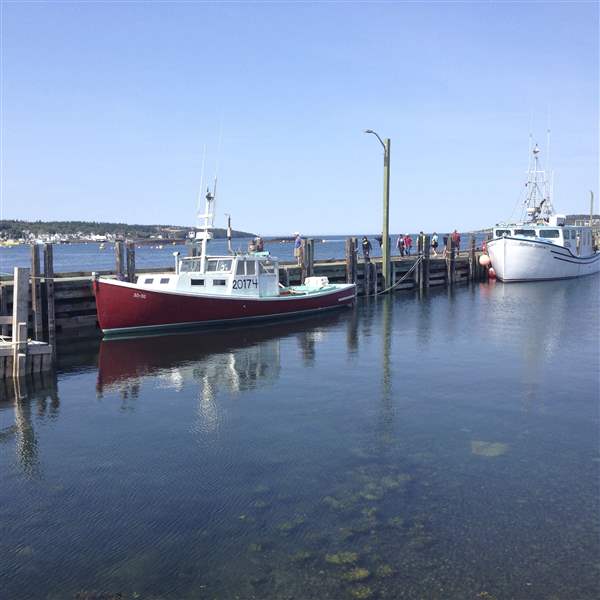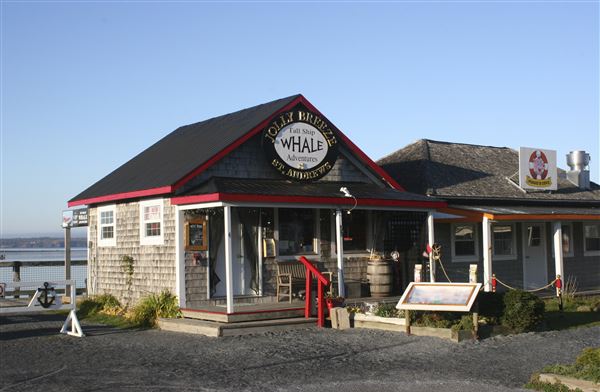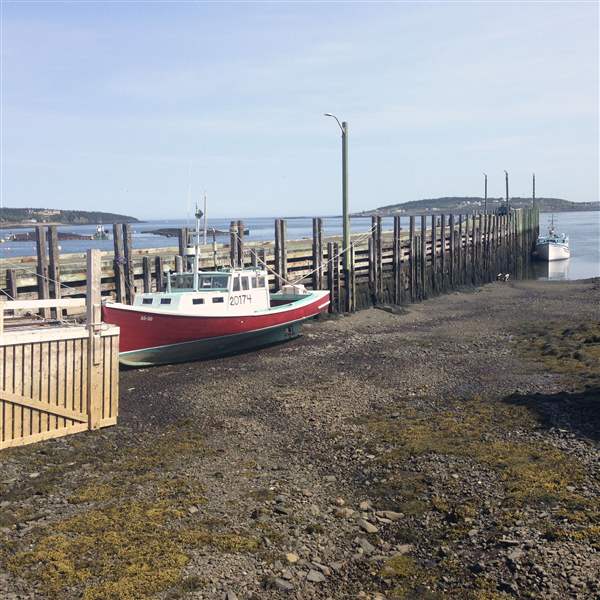
Boats float in the Bay of Fundy in New Brunswick at high tide. Larry Montrie
CLIMATE CHANGE: THE BAY OF FUNDY AND GULF OF MAINE...
CAPE ENRAGE, New Brunswick — It is here in the upper reaches of the Bay of Fundy that nature flexes its tidal muscles while sending a surge of 160 billion tons of seawater in and out of the funnel-shaped bay. That mass moves in with the force equal to that of 8,000 locomotive engines, scouring nutrients from the ocean bottom, the tidal flats, and marshes, while stirring up a smorgasbord of food for the whales, waterfowl, fish, and sea floor dwellers that make this rich fishery their home.
The tides here, the highest in the world, are equal in height to a five-story building when they play out in their most extreme manner. With two high tides and two low tides each day, that mega slosh of water, a volume greater than the combined flow of all of the freshwater rivers on the planet, refreshes and invigorates the Bay of Fundy, which joins the Grand Canyon and Yellowstone National Park among the seven wonders of North America.
RELATED CONTENT: Sense of urgency profound as natives of Canadian island battle the sea
And also, it is here that the warming of the planet’s oceans could be showing its hand.
Donald Killorn is the executive director at Eastern Charlotte Waterways Inc., an environmental resource and research center located in Blacks Harbour, not far from where the Bay of Fundy merges into the adjoining and much wider Gulf of Maine. Mr. Killorn says these waters, the fishery, and the impact they are experiencing because of a rising water temperature brought on by climate change know no international boundary.
“The temperature change we are experiencing here in the Bay of Fundy and in the Gulf of Maine is as severe as anywhere on the planet, and it is having a significant impact on the biodiversity of these waters,” Mr. Killorn said.
He cited studies that indicate the baseline temperature in the Gulf of Maine rose 0.03 degrees Celsius over the last 30 years, but in just the past decade, the waters have warmed at an alarming rate of 0.22 degrees C.
“The temperature change is so dramatic, and as a result we are seeing certain species in rapid decline, while others are on the increase,” Mr. Killorn said. “The data is significant. If this trend continues, we are going to have biodiversity more like the Chesapeake Bay than what this region has had in the past.”
For as long as the historical record has been kept, Atlantic cod was the anchor species of the Bay of Fundy/Gulf of Maine fishery, but the cod population has crashed, and experts point the accusatory finger at the warming waters.
In a report published in the journal Science, Andrew J. Pershing, chief scientific officer and ecosystem modeler at the Gulf of Maine Research Institute, said the warmer waters in the Gulf of Maine and the Bay of Fundy have seriously impacted cod stocks in terms of both reduced recruitment and increased mortality of this traditional mainstay of the industry.
“Failure to recognize the impact of warming on cod (numbers) contributed to overfishing,” Mr. Pershing said in the report. “Recovery of this fishery depends on sound management, but the size of the stock depends on future temperature conditions. The experience in the Gulf of Maine highlights the need to incorporate environmental factors into resource management.”
Mr. Pershing said that to the tourist, the visitor, and even many of the residents along this waterway, the sea looks essentially the same as it always has, but a dramatic transformation is taking place in the fathoms below the surface.
“There are big changes underneath. The first Europeans came to New England to harvest the incredible abundance of codfish, but cod are now much rarer,” he said. “Northern shrimp, which like cod are at the southern limit of their range in the Gulf of Maine, are also scarce and the fishery has been closed for four years.”
New species take over
On the opposite end of this altering environment are the species that do better in water that is slightly warmer than what the bay and the gulf have hosted in the past. Fishermen are experiencing booming harvests of lobsters, scallops, and halibut.
“Lobster are now incredibly abundant, up to five times more than they were in the 1980s,” Mr. Pershing said. “The lobster fishery in southern New England has all but disappeared, while the lobster fishery in Maine has been booming. And fishermen now encounter species like black sea bass that have traditionally been found south of Cape Cod.”
Greg Thompson has fished the waters of the Bay of Fundy for more than 40 years, and works his boat Macusela out of Dipper Harbour near the Point Lepreau Nuclear Generating Station on the New Brunswick side of the bay. Mr. Thompson, a fourth-generation Fundy fisherman, said he has observed the changes in the fishery that the scientific community has reported on.
“We’re certainly seeing an abundance of shellfish such as lobster and scallops,” Mr. Thompson said. “We’ve had cycles before, but this seems to be exceptional for a longer period, for lobsters particularly. And scallops have always been boom and bust, but right now this has been one of the longest up cycles for scallops that I’ve seen.”
But Mr. Thompson, a past president of the Fundy North Fishermen’s Association which represents small-scale commercial fishermen in the central and southern end of the bay, is not convinced that climate change is the primary force at play.
“It appears that the tides are a little higher than they used to be, and the ground fishery (which includes cod) is very poor,” he said. “We used to fish for salmon, we used to fish for cod, and we used to see whales in the bay in the summer, but they’ve not been coming into the bay in the last year or two. But it’s not easy to tie all of these changes to climate change. It could all be attributed to general fluctuations in the fishery, except for the tides.”
Mr. Killorn sees other connections, however, that could explain the dynamic nature of the lobster fishery and its connection to warming water. He believes the changing water temperature in the Bay of Fundy is the catalyst.
“There are always a lot of questions as to why, and why we have more lobster could be attributed to them being more active in warmer water, and lobsters growing more in warmer water,” he said. “But there is also the consideration that the decrease in the groundfish could be the result of warmer water, and those fish would eat a lot of juvenile lobster.”
Matthew Abbott is the Fundy baykeeper and marine conservation director for the Conservation Council of New Brunswick. He works closely with commercial fishermen to assess changes in the bay and its bounty. Mr. Abbott said the huge spike in the lobster harvest has been accompanied by a laundry list of negative alterations in the Bay of Fundy.
“Some of the lobster fishermen are catching in a day what they once caught in a whole season, but overall the diversity of fish is not nearly what it used to be,” he said. “This area is being hit hard with climate change. Fishing in coastal waters has been about adapting to change, and it is still about adapting to change. The difference is that climate change accentuates and makes less predictable the changes fisherman have to endure.”
Daniel Horton, an assistant professor in the Climate Change Research Group with the Department of Earth & Planetary Sciences at Northwestern University, said man’s role in how ocean fisheries are managed and harvested has likely made the situation more difficult to assess.
“Things are rather complicated due to human involvement,” he said. “Overfishing and the introduction of invasive species both play a role in complicating things.”
In that complication sequence Mr. Horton references, climate change has its fingerprints on other issues associated with the degradation of the fishery in the gulf and the bay, besides just warming the water.
“The changing water temperature is the biggest issue, and certainly the most localized, but it is not the only issue at all,” Mr. Killorn from the Eastern Charlotte Waterways environmental group said. “We’ve seen a dramatic decrease in plankton, and we’re not sure why. There is also the changing pH, and the role it plays is not easy to understand, but when we change ocean temperature and we change the acidity level or pH, we end up changing biodiversity."
Canaries in the coal mine
Bill Mook owns Mook Sea Farm on the Damariscotta River, which drains into the nearby Gulf of Maine, in Walpole, Maine. As a producer of commercially raised oysters, he relies on sea water from the gulf to nurture his stock, and as a member of Maine’s Commission to Study Ocean Acidification, Mr. Mook learned of the strong link between greenhouse gas emissions and global warming, which in turn creates a more acidic ocean, hindering the way oysters build strong shells.
“Everyone should know that ocean acidification is not something off in the future, but it is here now,” Mr. Mook said. “Our hatchery, where we grow our oysters through the early life stages, is the engine that drives our business and is what is most vulnerable to ocean acidification caused by climate change. Businesses like mine are the ‘canaries in the coal mine.’ ”

Saint Andrews, New Brunswick, juts into Passamaquoddy Bay on a peninsula near the border between the province and Maine. Businesses line the streets near the bay, which is an inlet from the Bay of Fundy. The Blade/Matt Markey
Alan Madden retired after 30 years as a fisheries and wildlife biologist with the New Brunswick Department of Natural Resources. He said there are too many signs to ignore in nature that indicate significant change.
“In the last decade, we’re seeing birds we’ve never seen before, moving northward, and we have more lightning events, more tornadoes — and this is all happening now,” he said. “The air has definitely warmed, so it follows that the waters are warming also. We talk about how we love global warming since it moderates our winters, but the reality is, it is doing much more harm.”
Mr. Killorn said that while the fishermen might be enjoying the days of plenty with the lobster harvest, he sees it as an indication of a “terrifying trend” that, should it continue, might spell disaster if the water warms too much. Warmer water has killed the lobster fishery to the south, and that fate could be in store for this region in the coming decades, he warned.
“Nature is unknowably intricate, and we’ve shown as a culture that we have no capability to manage fisheries, so we should expect a dramatic change in the biodiversity of the bay,” he said. “There is a real gap in the seriousness of the issue and the action we’ve taken to address it. We’ve had an eerily calm 10,000 years here on Earth, but we’ve done awful things to the planet and we have to figure it out.”
Contact Blade outdoors editor Matt Markey at: [email protected] or 419-724-6068.
source: http://www.toledoblade.com
original story HERE
To help do something about the climate change and global warming emergency, click here.
Sign up for our free Global Warming Blog by clicking here. (In your email, you will receive critical news, research, and the warning signs for the next global warming disaster.)
To share this blog post: Go to the Share button to the left below.


Be the first to comment
Sign in with